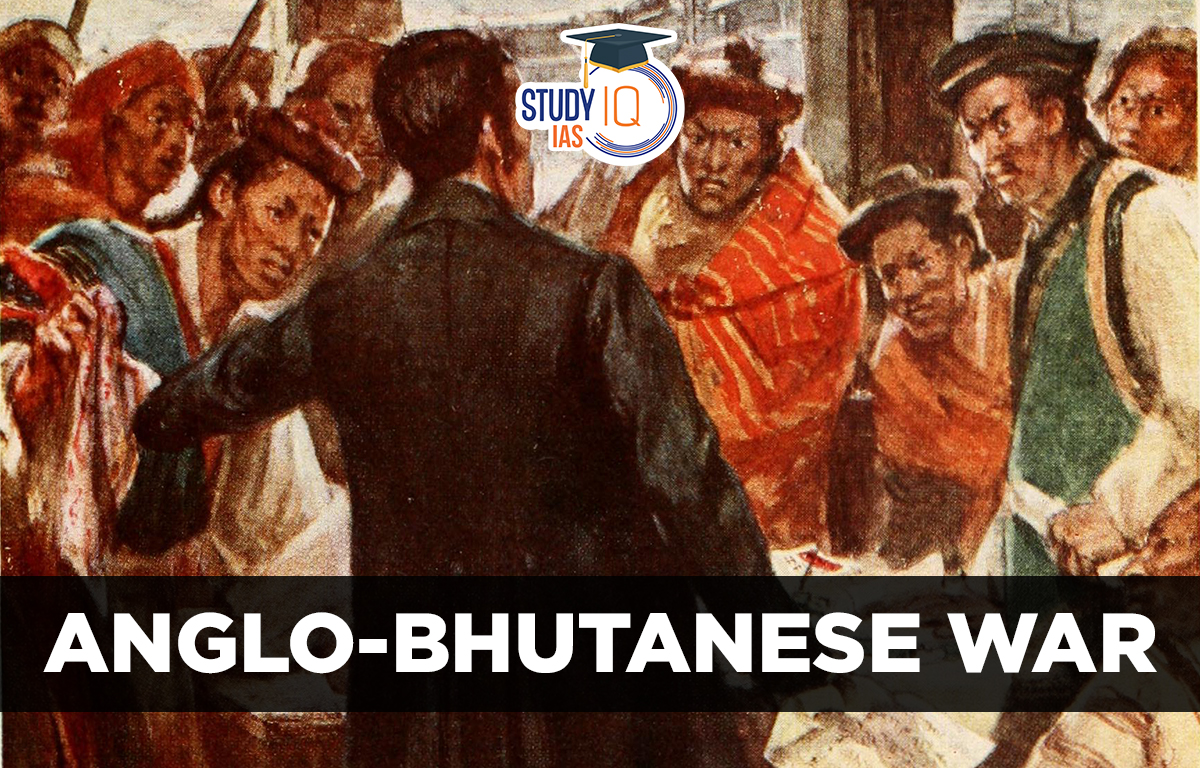Table of Contents
Anglo-Bhutanese War
The Bhutanese army was defeated in the Anglo-Bhutan war, commonly known as the Duar War. The “Treaty of Sinchula,” which was signed on November 11, 1865, brought about peace. In exchange for an annual subsidy of 50,000 rupees, Bhutan granted the British control over areas in the Assam Duars and Bengal Duars as well as about 80,000 kilometres of Dewangiri (Deothang). Thid article contains all the details related to Anglo- Bhutan war Important for the preparations of UPSC.
Read More: Anglo-Nepalese War
Anglo-Bhutanese War History
In many ways similar to Nepal, the state of Bhutan was the scene of a brief but ferocious battle in 1864 and 1865 that involved several Gurkha regiments. The Governor-General of India authorised a declaration of war on Bhutan in November 1864 in reaction to a pattern of raids south into British Indian territory and perceived slights against British envoys participating in ongoing political wars within Bhutan.
The Duar Field Force, made up of four columns of British, Indian, and Gurkha soldiers, including members of the 3rd and 8th Gurkha Rifles, marched north into the Bhutanese foothills. By January 1865, the forts at Dewangiri, Sidli, Buxa, and Daling had been taken relatively easily despite the need to make improvements to or clear paths through frequently dense jungle or swamp. When attacks by the local Bhutanese forces started throughout the entire line of captured forts and British-Indian fortifications, the general consensus was that Bhutan had been pacified, and orders were even issued for the demobilisation of the Daur Field Force.
While the majority of the attacks, including those against the Gurkhas stationed at Buxa, were thwarted, the attacks on the fort at Dewangiri presented significant challenges for the defenders, notably the Gurkhas. Bhutanese forces were able to cut off the fort’s communications and water supplies, leaving its defenders at the mercy of their own running out of ammunition.
The Dewangiri defenders planned a breakout early on February 5th, 1865, but the attempted evacuation was chaotic and resulted in the loss of most of the force’s supplies, weapons, and even some wounded. When news of these significant reverses reached Calcutta, two Brigades under the command of Brigadier-General Tombs, V.C., C.B., were dispatched as powerful reinforcements to retake the initiative.
A soldier from the 44th (Sylhet) Regiment of Bengal Native (Light) Infantry (an ancestor of 8GR), Bakhat Singh Rai, was one of the first to attack the Bhutanese stockade and would later get the Indian Order of Merit for his actions in helping the reorganized force retake Dewangiri by April 1865. Despite this, the conflict would continue for many more months in lesser engagements before the cannons lost in the retreat from Dewangiri were finally retrieved, putting a stop to hostilities.
Read More: Anglo-Burmese War
Anglo-Bhutanese War Causes
Early in January 1865, British goals were met, and it was considered that the Bhutanese were defeated. The Bhutanese, under the personal command of the Tongsa Penlop, swept down upon Dewangiri, one of the eastern posts that had been occupied, and, after cutting off the water supply, forced its evacuation on February the 5th. Barely had the British authorities decided to break up the expeditionary force.
Along the line of the captured region, similar attacks were launched with varied degrees of success. Before the reputation of British arms could be restored, the expeditionary force had to be completely reorganized, including the sending of reinforcements from Calcutta. Operations were suspended throughout the summer after the honour of recapturing the evacuated posts during the spring had been satisfied.
Read about: Anglo-Sikh War
Anglo-Bhutanese War Impact
It was decided to try to negotiate a resolution once more during this break in the storm. The Viceroy, Lord Lawrence, wrote the Deb and Dharma Rajas on June 2, 1865, proposing peace based on the British proclamation of November 1864. This did not yield the expected results, therefore Colonel Bruce decided to march into the country’s interior and gave the Deb Raja full notice in a letter dated September 28, 1865.
The Deb Raja consented to negotiate in a letter to Colonel Bruce dated October 4, 1865, as a result of the extensive war preparations. The outcome was a treaty that was signed on November 11th, 1865. The most significant provision of the Treaty of Sinchula was the ceding to Great Britain of all of the Bengal and Assam Duars, as well as a section of mountainous land on the left bank of the Tista River that is now known as the subdivision of Kalimpong, in perpetuity.
Bhutan was also given a compensation grant of an annual sum that would increase by increments up to a maximum of 50,000 Following was an enduring peace.
Read about: Anglo-Mysore War
Anglo-Bhutanese War UPSC
Bhutan and British India engaged in combat in the Anglo-Bhutanese War between 1864 and 1865. Since 1774, it has been the only time that the two states have engaged in combat. This article has all the details about Anglo-Bhutanese War for UPSC Exam Preparations.
Read More: Anglo-Afghan War


 Jallianwala Bagh Massacre, Date, History...
Jallianwala Bagh Massacre, Date, History...
 Important Lakes of India, State wise and...
Important Lakes of India, State wise and...
 Buddhism History, Origin, Sect, Councils...
Buddhism History, Origin, Sect, Councils...





















